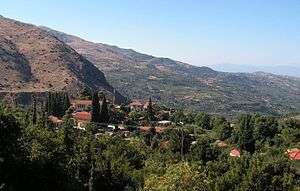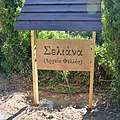Seliana
Seliana (Greek: Σελιάνα)[1] also known as Phelloe (Greek: Φελλόη) is a village in the municipal unit of Aigeira, in the eastern part of Achaea, north Peloponnese, Greece. The village had a population of 52 in 2011.[2] Aigeira is 10 km to the north, and Kalavryta is 21 km to the west. Seliana is connected by a 19 km road that leads to the town of Aegeira and the Greek National Road 8A, Athens - Corinth - Aigeira - Patras.


Geography
The village is built at an altitude of ~750 m on the foothills of the fir forest of Sarantapikho and on the eastern slope of the valley of river Krios. The forest lies between the villages of Seliana, Perithori, Sarantapikho and Zarouchla and it is the largest forest of Achaea consisting mainly of black pine trees, firs and chestnuts. Seliana is surrounded by lush vegetation, old Platanus trees, walnuts, hazelnuts, plums, peaches, and many springs and you can hear the rushes of the running water all year round. The few inhabitants are mainly engaged in livestock farming and farming and in the cultivation of Apple, Plum and vegetables (mainly bean cultivation, which is the traditional food of Seliana).
History
The village of Seliana coincides with ancient Phelloe[3][4][5] a small town of ancient Greece described in Pausanias book "Description of Greece - Achaea".[6][7] Excavations in the broader area of Seliana have been conducted by the Austrian Archaeological Institute at Athens, the Italian School of Archaeology at Athens, the University of Salerno and the Greek Ephorate of Prehistoric and Classical Antiquities. In the village there are few remnants of ancient Phelloe in different places but the most notable are those beside the old chapel of St. Basil where there is still an ongoing excavation (University of Salerno report identifies the observable wall beside the chapel as a construction of Hellenistic Period).[8][9] In the report of the archaeologists we read "Prospection covered the ca. 30ha of the territory of modern Seliana as defined by the Evrostina mountains and to the west by the Krios valley. Oral and written testimonia concerning site location were verified on the ground. Despite poor visibility, exploration revealed occupation from the Late Bronze Age to late antiquity". Seliana was officially designated as an archaeological site by the Greek Ministry of Culture in 1996.[10]
During the Greek War of Independence (1821-1830) in the broader area around Seliana two battles took place, one in the beginning of the revolution and one in the year 1827. Also four large caves which are located close to the village served as a shelter for women and children when the Turkish general Ibrahim Pasha of Egypt invaded north Peloponnese in 1827.[11]
There is a strong relation between the village of Seliana and the village of Selianitika. According to historian A. Fotopoulos the inhabitants of Seliana descended from the mountains to the coastal region of "Kryovrysi" near Aigio (where the village of Selianitika lies today) during the Ottoman period.[12] Initially the residents of Seliana were spending the winter in Selianitika and the summer in their village of Seliana but later they settled permanently. The residents of Seliana carried with them the parish of Saint Basil (the oldest of Seliana's churches) and today Saint Basil is the patron saint of the village of Selianitika. In 1853, Seliana is mentioned as the capital of the municipality of Phelloe and had a population of 590 (the whole municipality had 2883 and it included 7 villages of the area).[13] In the 1879 population census the village's population had increased to 671.[14]
Gallery
 Fountain in the village of Seliana with the inscription "Κρήνη η Φελλόη" meaning "fountain "Phelloe", the ancient name of the village
Fountain in the village of Seliana with the inscription "Κρήνη η Φελλόη" meaning "fountain "Phelloe", the ancient name of the village The small chapel of Saint Basil in the village of Seliana. It lies besides the remnants of ancient Phelloe.
The small chapel of Saint Basil in the village of Seliana. It lies besides the remnants of ancient Phelloe. The sign at the entrance of the village with the inscription "Σελιάνα - Αρχαία Φελλόη" (Seliana - Ancient Phelloe)
The sign at the entrance of the village with the inscription "Σελιάνα - Αρχαία Φελλόη" (Seliana - Ancient Phelloe) The renovated old primary school of Seliana, built in 1904. The construction was funded by the Greek banker and philanthropist Andreas Syngros
The renovated old primary school of Seliana, built in 1904. The construction was funded by the Greek banker and philanthropist Andreas Syngros
Notes
- Γεώργιος Κανελλόπουλος, Ιστορία και Λαογραφία των χωριών και οικισμών της Ανατολικής Αιγιαλείας - Καλαβρύτων, Αθήνα 1981. (History and Folklore studies of the villages and settlements of Eastern Aigialeia and Kalavryta regions, Georgios Kanellopoulos, Athens, 1981, in Greek)
- Kolonas L., Museum of Aigio, Ταμείο Αρχαιολογικών Πόρων και Απαλλοτριώσεων, Athens 2004 ISBN 960-214-254-5 (in Greek)
- Αθ. Φωτόπουλος, Ιστορικά και Λαογραφικά της Ανατολικής Αιγιάλειας και Καλαβρύτων, Αθήνα 1982 (Historic And Demographics Of The Eastern Area of Aigialeia And Kalavryta, Ath. Fotopoulos, Athens 1982, in Greek)
References
- Information about the village of Seliana (in Greek)
- Απογραφή Πληθυσμού - Κατοικιών 2011. ΜΟΝΙΜΟΣ Πληθυσμός (in Greek). Hellenic Statistical Authority.
- First campaign of archaeological surveys in Aigialeia - October 2002 (Dipartimento di beni culturali , University of Salerno, Italy)
- W. Alzinger - E. Lanschützer – G. Ch. Neeb – R. Trummer,'Aigeira – Hyperesia und die Siedlung Phelloë in Achaia. Teil III: Palati, Zur Wasserversorgung von Aigeira , Phelloë' , Klio 68, 1986, 2, 309 – 347 (In German)
- Scuola Archeologica Italiana di Atene, Egialea Prospezioni (campagna 2009)
- Pausanias, Description of Greece, 7.26.10-11 (Perseus Project Digital Library - University of Tufts)
- Article about the Archaeological Museum of Aigion in the Greek magazine "Archaeologia". In the 2nd page we see the photo of a three-legged lebes (725-700 B.C.) found in Seliana
- First campaign of archaeological surveys in Aigialeia - October 2002 (Dipartimento di beni culturali , University of Salerno, Italy)
- SAIA Salerno reports on the seventh season of survey conducted in 2009 in Seliana
- Ιστοτοπος Εθνικού Τυπογραφίου - ΦΕΚ Β' 1029/12-11-96, Κήρυξη περιοχής κοινότητας Σελιάνας ως Αρχαιολογικού χώρου (Official Government Gazette of Greece, no. 1029/12-11-96) (pdf file in Greek)
- Σύγχρονος Εγκυκλοπαίδεια Ελευθερουδάκη μετά πλήρους Λεξικού της Ελληνικής, Εκδόσεις Ν. Νίκας & Σία Ε.Ε., 1962 (Article about Seliana in the 21th-volume of the Greek Encyclopedia Eleftheroudakis (24 volumes), 1962 (in Greek)
- Historic And Demographics Of The Eastern Area of Aigialeia And Kalavryta, Ath. Fotopoulos, Athens 1982 (in Greek)
- "ΕΛΛΗΝΙΚΑ", Historical, geographical, archaeological and statistical description of ancient and modern Greece, by Iakovos Ragkavis, published in Athens, 1853 (3 volumes) available in books.google.com
- Official document of Greece's population census 1879